- Tutorials
- Stances ( 서기 sogi )
- Left Side Stance ( 왼 서기 wen-sogi )
Taekwondo 태권도Taekwondo Preschool
When you reach senior belt you are expected to guide the junior belts when they are beginning Taekwondo such as showing by example. To advance from one rank to the next, students typically complete promotion tests in which they demonstrate their proficiency in the various aspects of the art before a panel of judges or their teacher. View Taekwondo belt levels »

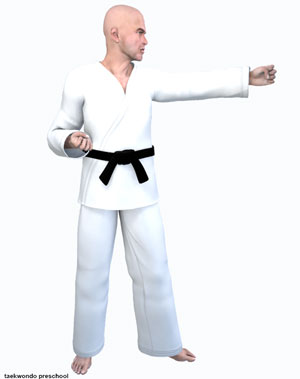
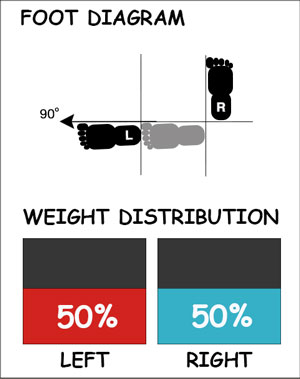


Left Side Stance
왼 서기 wen-sogi
Difficulty Level: Intermediate Level Technique: Stance ( 서기 sogi )

For the Left Side Stance ( 왼 서기 wen-sogi ), pivot the left heel ( 뒤축 dwichuk ) 90 degrees to the left from a Parallel Stance ( 나란히서기 naranhi-sogi ). The right foot is facing straight forward. The stance ( 서기 sogi ) should be one foot-length apart and both legs are straight. The weight is evenly distributed on both legs at 50/50 ratio and the center of the body should be in the middle.
In taekwondo, the Left Side Stance ( 왼 서기 wen-sogi ) is most commonly performed with the Hammer Fist Downward Strike ( 메주먹 내려치기 mejumeok-naeryeo-chigi ), Outward Back Fist ( 등주먹 바깥치기 deung-jumeok-bakkat-chigi ), and Hand Blade Side Strike ( 손날 옆치기 sonnal-yeop-chigi ) in patterns ( 품새 poomse ) and self-defense ( 호신술 hosinsool ).
Use of this stance ( 서기 sogi ) is featured prominently in many of the World Taekwondo (WT) Poomse. Taekwondo poomse are the learning ground for real combat. As such, the muscles of the body should be lightly relaxed in order to perform the pattern with fluidity, speed and grace. Muscles should only be tensed at the moment of imaginary impact in order to commute maximum power to any individual taekwondo technique.
Practitioners must have their body weight correctly distributed during each different stance ( 서기 sogi ) and during footwork ( 딛기 ditgi ). Each technique must be correctly aligned. Every technique must display the requisite speed, power and firmness to be realistically used as an attack or defense move.
Training Methods
How well one improves with training depends on several factors, such as the frequency it is engaged in, and the type of feedback that is available for improvement. If a student does not train often enough, reinforcement fades, and he or she is likely to forget what was learned.
When learning the stance ( 서기 sogi ), it is helpful to use a mirror to observe your stance ( 서기 sogi ) posture and fix your mistakes immediately. Initially, a student may need focused feedback from a certified Master Instructor ( 사범님 sabeomnim ); however, as they progress, they must develop the ability to self-assess the stance ( 서기 sogi ).
Minimum Level Requirement: Blue Stripe Belt (5th geup)
Difficulty of Technique
Taekwondo students of geup ranking learn the most basic techniques first, and then move on to more advanced and difficult techniques as they approach 1st Dan Black Belt. The more difficult the technique, the more practice may be needed for the purpose of improving or mastering it, as in the phrase 'practice makes perfect'. Every technique must display the requisite speed, balance, power and firmness to be realistically used as an attack or defense move.
* Please see a certified Master Instructor ( 사범님 sabeomnim ) for training. Proper guidance and instructions are needed to ensure safe training.
Promotion Tests
Students often undergo periodic testing and grading by their own Master Instructor ( 사범님 sabeomnim ) in order to advance to a higher level of recognized achievement such as a different belt color. They need to demonstrate their proficiency in the various aspects of the art such as the execution of patterns ( 품새 poomse ), which combine various techniques in specific sequences.
Left Side Stance ( 왼 서기 wen-sogi ) is a requirement for the below belt levels (Techniques vary between schools). Promotion from one belt level to the next can proceed rapidly in some schools, since schools often allow geup promotions every two, three, or four months. Students of geup rank learn the most basic techniques first, and then move on to more advanced techniques as they approach first dan black belt. View Promotion Tests »
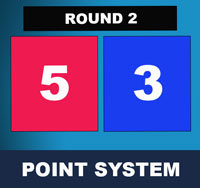
Highlight World Taekwondo (WT) Tournament Point System
Under World Taekwondo (WT) and Olympic rules, sparring ( 겨루기 gyeorugi ) is a full-contact event and takes place between two competitors in an area measuring 8 meters square. Points are awarded for permitted, accurate, and powerful techniques to the legal scoring areas; light contact does not score any points. The only techniques allowed are kicks ( 차기 chagi ) (delivering a strike using an area of the foot below the ankle) and punches ( 지르기 jireugi ) (delivering a strike using the closed fist). The referee can give penalties at any time for rule-breaking, such as hitting an area not recognized as a target, usually the legs or groin ( 샅 sat ). View Tournament Point System »
* Please see a certified Master Instructor ( 사범님 sabeomnim ) for training. Proper guidance and instructions are needed to ensure safe training.
Advertisement

Did you know?
Taekwondo Mental Toughness


Mental toughness is very hard to explain through words and can truly be understood when put to the test in an intense situation where you feel like you are at a breaking point, and find an inner will within you to push forward and overcome the situation. There are those who face stressful situations and back down and let them trample them, these people crumble during life. Then there are those who when faced with stressful, energy draining situations take them by the horns and conquer them, and it fills you with such a great energy and confidence, that helps you with every obstacle that you have from there on. For more information View Mental Toughness »
Indomitable spirit ( 백절불굴 baekjul-boolgool ): To have indomitable spirit means to have the courage to stand up for what you believe in, no matter what odds you are up against, and to always give 100% effort in whatever you do.
Self-control ( 극기 geuk-gi ): This means to not only have control over one's physical acts, but also their mental thoughts and actions.
Perseverance ( 인내 in-nae ): One will persevere time and time again until they have achieved a result which is adequate towards what one was trying to achieve.
RESOURCES
This article uses material from the Wikipedia articles "Mental Toughness" and "International Taekwondo Federation Philosophy" which is released under the Creative Commons Attribution-Share-Alike License 3.0.
Left Side Stance ( 왼 서기 wen-sogi )
Footing Surface
Various surfaces of the foot may be engaged as the footing surface depending on which area of the body is being used. Proper footwork is used to enable the proper balancing of the body, to support combinations of strikes and launch strikes from the proper angle or distance. For more information on Impact Surface Areas »
( Click image for additional information)
Technique Injuries
Collisions with the ground, objects, and other taekwondo practitioners are common, and unexpected dynamic forces on limbs and joints can cause injury. Taekwondo injuries can also occur in techniques if done improperly or from overuse of a particular body part. Taking a break from training or reducing the volume and the intensity of the training will allow the body to recover. For more information on Injuries »
( Click image for additional information)
Some Techniques used in this Stance ( 서기 sogi )
An example of the union of mental and physical discipline is the combination of stance ( 서기 sogi ), footwork ( 딛기 ditgi ), and technique (either with block and/or strike), which requires both physical mastery of the technique and the concentration to focus one's power. Experienced practitioners learn through repetition and muscle memory when (not just how) to launch particular techniques, based on the circumstances they are facing.
( Click image for additional information)

Training Highlights Summary
The Stance ( 서기 sogi ) contains many key point highlights. There are some that are simple and straightforward but then some are complex and detailed that require repeated training to learn and master.
- pivot the left heel 90 degrees to the left from a parallel stance
- the right foot is facing straight forward
- should be one foot-length apart and both legs are straight
- body is slightly turned naturally to the left side
- distribute 50/50 weight ratio on the left and right legs
- the arms position will depend on the technique being used
* Please see a certified Master Instructor ( 사범님 sabeomnim ) for training. Proper guidance and instructions are needed to ensure safe training.
Left Side Stance ( 왼 서기 wen-sogi )
Use in Sparring ( 겨루기 gyeorugi )
Under World Taekwondo (WT) and Olympic rules, sparring is a full-contact event and takes place between two competitors in an area measuring 8 meters square. A win can occur by points, or if one competitor is unable to continue (knockout) the other competitor wins. Points are awarded for permitted, accurate, and powerful techniques to the legal scoring areas; light contact does not score any points. For more information on World Taekwondo (WT) Tournament Sparring » 
( Click image for additional information)
Use in Self-Defense ( 호신술 hosinsool ) Applications
Self-Defense is to protect yourself from being attacked from would-be aggressors. It is a countermeasure that involves defending the health and well-being of oneself from harm and is designed primarily to cause injury or quickly incapacitate an attacker, in addition to being a deterrent against them. Attackers are typically larger, stronger, and are often armed or have an accomplice. With proper execution attackers may be incapacitated with a single blow, which lessens the number of attacks with multiple people. For more information on Self-Defense ( 호신술 hosinsool ) »
Practitioners must have their body weight correctly distributed during the stance ( 서기 sogi ) including proper footwork ( 딛기 ditgi ). Each technique must be correctly timed and aligned in order to defend effectively. The stance ( 서기 sogi ) is commonly performed during Self-Defense ( 호신술 hosinsool ) scenarios.
( Click image for additional information)
Use in One-Step Sparring
One-Step Sparring is performed with a partner in which predefined movements are practiced. One student is the attacker while the other student responds with defenses, counterattacks, and/or other actions, based on part of the predefined movements. For more information on One-Step Sparring »
The stance ( 서기 sogi ) is commonly featured during One-Step Sparring practice. Fundamentally, taekwondo One-Step Sparring is one of the learning grounds for real combat. As such, every technique including stance ( 서기 sogi ) must display the requisite speed, power and firmness to be realistically used as an attack or defense move. One-Step Sparring varies between schools.
( Click image for additional information)
Use in Breaking ( 격파 gyeokpa )
The discipline of destroying inanimate objects such as wooden boards, baseball bats, ice blocks or cement bricks and is a feature common to martial arts including taekwondo. A single board or stack of boards may be broken or, alternatively, a series of boards may be broken in a pre-set sequence utilizing a variety of strikes. Advanced competitors may even break several boards in a single jump with multiple kicks before landing. For more information on Breaking ( 격파 gyeokpa ) »
In use, the stance ( 서기 sogi ) is featured during Breaking ( 격파 gyeokpa ) events. General qualities that judges look for in any taekwondo practitioner include proper breathing technique and body control. The diaphragm must be engaged in deep breathing, shallow breathing concentrated in the upper abdomen results in raised shoulders and stressed muscles. Breaking ( 격파 gyeokpa ) varies between schools.
( Click image for additional information)
Advertisement
Left Side Stance ( 왼 서기 wen-sogi )
Use in Patterns ( 품새 poomse )
Stance is introduced in the following patterns:
PALGWE: 8
Poomse is the foundation for the teaching of taekwondo. A poomse or form is a detailed pattern of defense-and-attack motions and techniques used in traditional martial arts. Poomse is useful in developing proper kinetics, mental and physical fortitude.
( Click image for additional information)
Most Kukkiwon 국기원 schools will use the poomse taegeuk whereas a few schools will use the poomse palgwe. The meanings, trigrams and symbols are shared by both poomse taegeuk and poomse palgwe, however the sequence of movements is different. The first 8 forms of the set of poomse differ from each other, whereas the last 9 forms (Black Belt forms) of the set are shared between the two sets. All students studying in World Taekwondo (WT) Kukkiwon style must learn these forms, or taegeuk, to advance to a higher belt level. There are eight taegeuk forms, each one similar to the previous one, but each time with more complicated techniques to display the students' mastery of the techniques learned during lessons, as well as the ability to interconnect these techniques.
For more information on taekwondo patterns refer to Poomse 품새 Section »
Learn other taekwondo stances on the Stance ( 서기 sogi ) Section »
Practitioners must have their body weight correctly distributed during each different stance and during footwork. Each technique must be correctly aligned. Every technique must display the requisite speed, power and firmness to be realistically used as an attack or defense move.
Use in Demonstrations
To promote taekwondo for its emphasis on high kicking and fast hand techniques, taekwondo schools perform at tournaments, community events, shopping malls, parks, and tv shows. Demonstrations vary from school to school, but may include such elements as the execution of poomse ( 품새 poomse ), which combine various techniques in specific sequences; the breaking of boards to demonstrate the ability to use techniques with both power and control; sparring ( 겨루기 gyeorugi ) and self-defense ( 호신술 hosinsool ) to demonstrate the practical application and control of techniques; physical fitness usually with push-ups and sit-ups. For more information on Demonstrations »
The stance ( 서기 sogi ) is commonly used in demonstration activities such as when performing poomse ( 품새 poomse ) which is the foundation for the teaching of taekwondo. A poomse ( 품새 poomse ) is a series of movements linked together in a prescribed sequence which is significant to demonstrate. As such, every technique must display the requisite speed, power and firmness to be realistically used as an attack or defense move.
( Click image for additional information)
Use in Warming-Up
A warm-up generally consists of a gradual increase in intensity in physical activity, joint mobility exercise, and stretching, followed by the activity. Warming-up brings the body to a condition at which it safely responds to nerve signals for quick and efficient action. For more information on Warming-Up »
In addition to being a stance ( 서기 sogi ) in itself, the stance ( 서기 sogi ) is an exercise used by many instructors to teach the principle of focusing, stretching, relaxing the muscles, increasing the range of motion and flexibility, something which is considered important in taekwondo. The result is a feeling of increased muscle control, flexibility and range of motion.
( Click image for additional information)
Left Side Stance ( 왼 서기 wen-sogi )
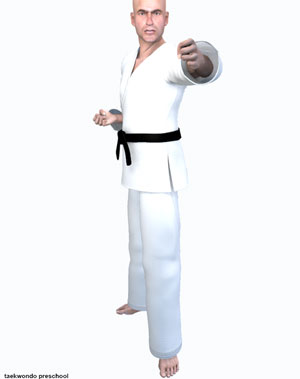
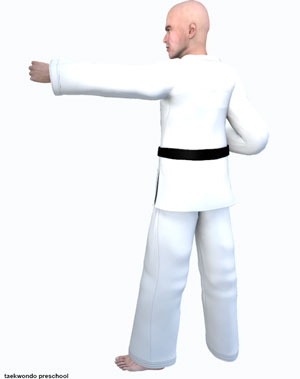
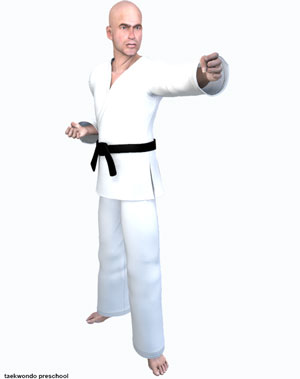

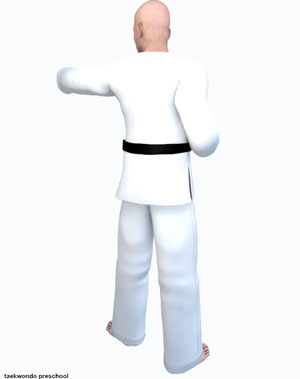
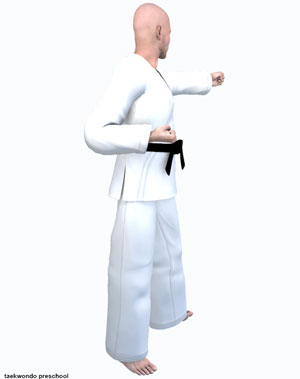
Additional Resources
Taekwondo Stances ( 서기 sogi )
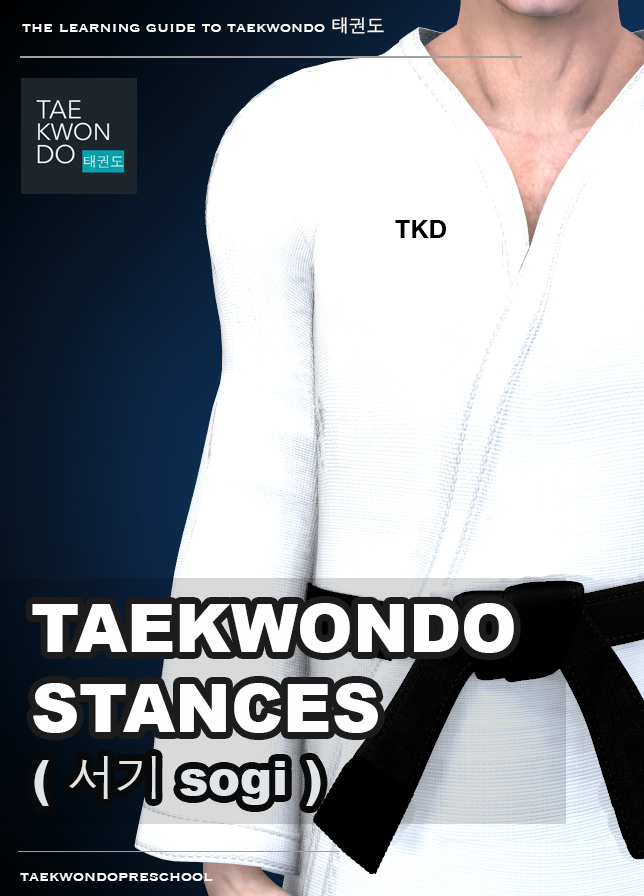
This book is available for download with Apple Books on your Mac or iOS device, and with iTunes on your computer. Book can be read with Apple Books on your Mac or iOS device.
The Korean martial arts taekwondo has several stances ( 서기 sogi ) used for different activities. Although there are strong similarities in stances ( 서기 sogi ) throughout taekwondo schools, individual instructors often have their own preferred style. These stances ( 서기 sogi ) are most commonly seen in taekwondo forms ( 품새 poomse ), and are critical for balance, precision, and good technique in the martial art.
View more information about Book »

Quiz
Question. In what year was the World Taekwondo Federation (WTF) officially established?
The World Taekwondo Federation is the International Federation [IF] governing the sport of Taekwondo and is a member of the Association of Summer Olympic International Federations [ASOIF]. The WTF was established at its inaugural meeting held at the Kukkiwon ( 국기원 ) with participation of 35 representatives from the world and until this day there is a total of 205 Member Nations. The World Taekwondo Federation (WTF) has renamed itself to World Taekwondo (WT) in 2017.
Question. In what year was the World Taekwondo Federation (WTF) officially established?
Answer you gave was: 1971
Your answer is wrong! You need to study more!

The World Taekwondo Federation (WTF) was established on May 28, 1973 (Renamed itself to World Taekwondo (WT) in 2017). According to the WTF, "Taekwondo is one of the most systematic and scientific Korean traditional martial arts, that teaches more than physical fighting skills. It is a discipline that shows ways of enhancing our spirit and life through training our body and mind". Today, it has become a global sport that has gained an international reputation, and stands among the official games in the Olympics.
Question. In what year was the World Taekwondo Federation (WTF) officially established?
Answer you gave was: 1973
Your answer is correct! Great Job!

The World Taekwondo Federation (WTF) was established on May 28, 1973 (Renamed itself to World Taekwondo (WT) in 2017). According to the WTF, "Taekwondo is one of the most systematic and scientific Korean traditional martial arts, that teaches more than physical fighting skills. It is a discipline that shows ways of enhancing our spirit and life through training our body and mind". Today, it has become a global sport that has gained an international reputation, and stands among the official games in the Olympics.
Question. In what year was the World Taekwondo Federation (WTF) officially established?
Answer you gave was: 1975
Your answer is wrong! You need to study more!

The World Taekwondo Federation (WTF) was established on May 28, 1973 (Renamed itself to World Taekwondo (WT) in 2017). According to the WTF, "Taekwondo is one of the most systematic and scientific Korean traditional martial arts, that teaches more than physical fighting skills. It is a discipline that shows ways of enhancing our spirit and life through training our body and mind". Today, it has become a global sport that has gained an international reputation, and stands among the official games in the Olympics.
Question. In what year was the World Taekwondo Federation (WTF) officially established?
Answer you gave was: 1977
Your answer is wrong! You need to study more!

The World Taekwondo Federation (WTF) was established on May 28, 1973 (Renamed itself to World Taekwondo (WT) in 2017). According to the WTF, "Taekwondo is one of the most systematic and scientific Korean traditional martial arts, that teaches more than physical fighting skills. It is a discipline that shows ways of enhancing our spirit and life through training our body and mind". Today, it has become a global sport that has gained an international reputation, and stands among the official games in the Olympics.
Question. What is the name of Taegeuk #3 in Korean?
Taegeuk 태극 (in World Taekwondo (WT)) refers to a set of poomse 품새 used to create a foundation for the teaching of taekwondo. A poomse or form is a detailed pattern of defense-and-attack motions and techniques used in traditional martial arts. Each taegeuk form symbolizes a specific state thought to be indicative of the belt the student currently holds, and is represented in World Taekwondo (WT) by trigrams similar to those found in the four corners of the South Korean flag.
Question. What is the name of Taegeuk #3 in Korean?
Answer you gave was: Chil Jang
Your answer is wrong! You need to study more!


The trigram associated with this poomse represents a Mountain. Also, it represents the northwest and youngest son. The symbolism behind the mountain is the indomitable and majestic nature that all mountains possess. This poomse is intended to be performed with the feeling that all movements are this majestic due to their unconquerable nature.
Question. What is the name of Taegeuk #3 in Korean?
Answer you gave was: Sam Jang
Your answer is correct! Great Job!


This trigram represents Fire. Related to this symbol is also East and the relationship of the Second Daughter. Fire contains a lot of energy. The symbol behind the fire is similar to the symbolism of the water in that both can aid and both can destroy. This form is intended to be performed rhythmically, with some outbursts of energy to reflect fire's rhythmic and energetic dualism.
Question. What is the name of Taegeuk #3 in Korean?
Answer you gave was: Yi Jang
Your answer is wrong! You need to study more!
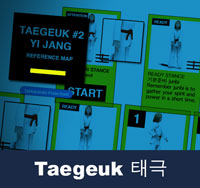

The associated trigram of this poomse represents the Lake. Also, related to the symbol is South East and the relationship of the youngest daughter. The movements of this Taegeuk are aimed to be performed believing that man has limitations, but that we can overcome these limitations. The Lake and its water symbolize the flowing and calm nature of the martial artist.
Question. What is the name of Taegeuk #3 in Korean?
Answer you gave was: Sa Jang
Your answer is wrong! You need to study more!


This trigram represents Thunder. Also, the trigram is strongly connected to northeast and the relationship of the Eldest son. Thunder comes from the sky and is absorbed by the earth, thus, according to the beliefs of the I Ching, thunder is one of the most powerful natural forces. This poomse is associated with power and the connection between the heavens and earth.
Question. What is the korean terminology for Front Stance?
Front Stance is a precursor of the fighting stance ( 겨루기준비 gyeorugi-junbi ) according to some martial arts authors. Body should be relaxed in this stance ( 서기 sogi ) when performed in patterns ( 품새 poomse ) and self-defense ( 호신술 hosinsool ). Although the specifics of the stance vary by style, overall it is visually similar to a lunge, with the forward leg bent at the knee, and the rear leg straight, while the hips and shoulders remain squarely facing forward.
Question. What is the korean terminology for Front Stance?
Answer you gave was: ( 뒷굽이 dwi kubi )
Your answer is wrong! You need to study more!
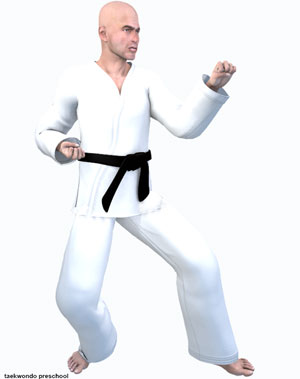
Back Stance ( 뒷굽이 dwi kubi ) is specifically focused on shifting weight to the back leg, as it offers much more control, and makes it easier to kick off the front leg. To perform the Back Stance ( 뒷굽이 dwi-kubi ), the body faces to the side, with the front foot facing forward and the front leg bent. The back leg is bent slightly and the foot is turned outwards perpendicular to the front foot making the letter "L" for this stance ( 서기 sogi ).
Question. What is the korean terminology for Front Stance?
Answer you gave was: ( 주춤서기 juchum sogi )
Your answer is wrong! You need to study more!

The Horse-Riding Stance ( 주춤서기 juchum-sogi ) is a beginner stance ( 서기 sogi ) generally used to practice punches ( 지르기 jireugi ) and blocks ( 막기 makgi ). It is similar to the Ready Stance ( 기본준비 junbi ) but the feet are placed much wider, about two-foot length's apart. Also, the knees ( 무릎 mureup ) are deeply bent and the shins ( 정강이 jeonggangi ) should be kept slightly perpendicular to the floor.
Question. What is the korean terminology for Front Stance?
Answer you gave was: ( 앞굽이 ap kubi )
Your answer is correct! Great Job!

Front Stance ( 앞굽이 ap-kubi ) is one of the most important techniques to learn when starting taekwondo as a beginner. The distance between the inside edges or namely the Reverse Foot Blade ( 발날등 balnaldeung ) of both feet should be between one to two fists apart and is about 4 to 4 one-half foot-length from origin. Rear toes are turned outward about 30 degrees and the body is also naturally angled at 30 degrees or facing straight forward depending on the upper body technique.
Question. What is the korean terminology for Front Stance?
Answer you gave was: ( 앞서기 ap sogi )
Your answer is wrong! You need to study more!

The Walking Stance ( 앞서기 ap-sogi ) is a beginner stance ( 서기 sogi ) that is used to approach or retreat in combat and patterns ( 품새 poomse ). Feet should be maintained approximately 3 foot-length from origin. To maintain a solid base, the front foot is facing straight forward and the back foot is 30 degrees to aid balance. Use of this stance ( 서기 sogi ) is featured prominently in many of the World Taekwondo (WT) Poomse.
TAEKWONDO STANCES ( 서기 sogi ) |
|||||
| Hangul 한글 | Korean | Belt Requirement | Difficulty Level | Tutorial | |
| Attention Stance | 차렷 | charyeot |   |
Beginner Level | Tutorial » |
| Ready Stance | 기본준비 | junbi |   |
Beginner Level | Tutorial » |
| Front Stance | 앞굽이 | ap-kubi |   |
Beginner Level | Tutorial » |
| Horse Riding Stance | 주춤서기 | juchum-sogi |   |
Beginner Level | Tutorial » |
| Two Fist Ready Posture | 두주먹허리준비 | dujumeok-heori-junbi |   |
Beginner Level | Tutorial » |
| Fighting Stance | 겨루기준비 | gyeorugi-junbi |    |
Beginner Level | Tutorial » |
| Walking Stance | 앞서기 | ap-sogi |   |
Beginner Level | Tutorial » |
| Parallel Stance | 나란히서기 | naranhi-sogi |   |
Beginner Level | Tutorial » |
| Inward Stance | 안쫑서기 | anjjong-sogi |   |
Beginner Level | Tutorial » |
| At Ease Stance | 편히서기 | pyeoni-sogi |   |
Beginner Level | Tutorial » |
| Back Stance | 뒷굽이 | dwi-kubi |    |
Intermediate Level | Tutorial » |
| Side Stance | 옆서기 | yeop-sogi |  |
Intermediate Level | |
| Left Stance ”L” Shape | 왼 서기 | wen-sogi |  |
Intermediate Level | Tutorial » |
| Right Stance ”L” Shape | 오른 서기 | oreun-sogi |  |
Intermediate Level | Tutorial » |
| Cross Stance | 꼬아서기 | koa-sogi |   |
Intermediate Level | |
| Rear Cross Stance | 뒤 꼬아서기 | dwi-koa-sogi |   |
Intermediate Level | Tutorial » |
| Covered Fist Posture | 보주먹준비 | bojumeok-junbi |  |
Intermediate Level | Tutorial » |
| Tiger / Cat Stance | 범서기 | beom-sogi |   |
Intermediate Level | Tutorial » |
| Forward Cross Stance | 앞 꼬아서기 | ap-koa-sogi |   |
Intermediate Level | Tutorial » |
| ‘ㅗ’ Shape Stance | ‘ㅗ’ 자 서기 | oja-sogi |   |
Advanced Level | |
| Log Pushing Hands Posture | 통밀기준비 | tongmilgi-junbi |   |
Advanced Level | Tutorial » |
| Crane Stance | 학다리서기 | hakdari-sogi |  |
Advanced Level | Tutorial » |
| Overlapped-Hand Posture | 겹손준비 | gyeopson-junbi |  |
Advanced Level | Tutorial » |
| Inner Knee Stance | 오금서기 | ogum-sogi |  |
Advanced Level | Tutorial » |
| Assisting Stance | 곁다리서기 | gyeotdari-sogi |  |
Advanced Level | Tutorial » |
Advertisement
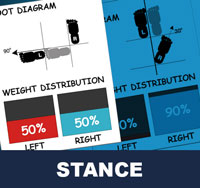

Related Articles
The korean martial arts taekwondo has several stances ( 서기 sogi ) used for different activities. Practitioners must have their body weight correctly distributed during each different stance and during footwork. Each technique must be correctly aligned. Although there are strong similarities in stances throughout taekwondo schools, individual instructors often have their own preferred style. For information View Taekwondo Stances ( 서기 sogi ) »
- Ready Stance ( 기본준비 junbi )
- Walking Stance ( 앞서기 ap-sogi )
- Front Stance ( 앞굽이 ap-kubi )
- Attention Stance ( 차렷 charyeot )
- Fighting Stance ( 겨루기준비 gyeorugi-junbi )
- Parallel Stance ( 나란히서기 naranhi-sogi )
- Horse Stance ( 주춤서기 juchum-sogi )
- Back Stance ( 뒷굽이 dwi-kubi )
- Covered Fist Ready Stance ( 보주먹준비 bojumeok-junbi )
- Log Pushing Posture ( 통밀기준비 tongmilgi-junbi )
- Overlapping Hand Posture ( 겹손준비 gyeopson-junbi )
- Assisted Stance ( 곁다리서기 gyeotdari-sogi )
- Inward Stance ( 안쫑서기 anjjong-sogi )
- Left Side Stance ( 왼 서기 wen-sogi )
- Right Side Stance ( 오른 서기 oreun-sogi )
- Cat Stance ( 범서기 beom-sogi )
- Forward Cross Stance ( 앞 꼬아서기 ap-koa-sogi )
- Rear Cross Stance ( 뒤 꼬아서기 dwi-koa-sogi )
- Crane Stance ( 학다리서기 hakdari-sogi )
- Inner Knee Stance ( 오금서기 ogum-sogi )
- Two Fist Ready Stance ( 두주먹허리준비 dujumeok-heori-junbi )
- At Ease Stance ( 편히서기 pyeoni-sogi )
- Closed Stance ( 모아서기 moa-sogi )
- Forward Riding Stance ( 앞 주춤서기 ap-juchum-sogi )
There are five tenets defined in the International Taekwondo Federation (ITF) and several more in World Taekwondo (WT).
Integrity ( Yeom Chi / 염치 ): "Although it may be similar, this form of integrity takes on a more wider role then defined in the common dictionary. In taekwondo, integrity means not only to determine what is right or wrong but also having the conscience to feel guilt if one has done wrong and to have the integrity stand up for what is right." View Taekwondo Tenets »
RESOURCES
This article uses material from the Wikipedia article "Taekwondo Stances", which is released under the Creative Commons Attribution-Share-Alike License 3.0.








